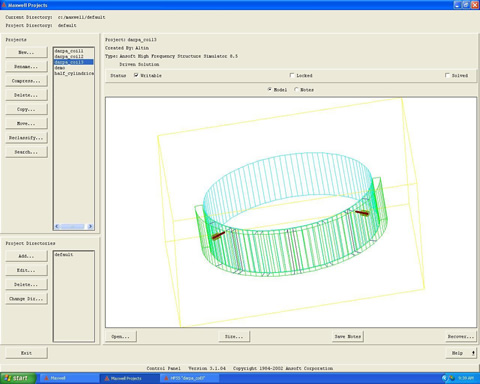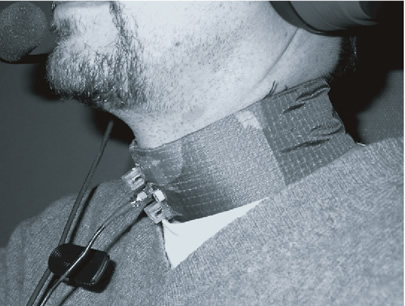tuned electromagnetic resonator collar sensor
This project was sponsored by DARPA/NAVSEA as part of their Advanced Speech Encoding (ASE) Program and the work was performed between October 2002 and March 2004. The Principle Investigators on this project were Prof. Rick Brown and Prof. Reinhold Ludwig. Two graduate students were responsible for much of the work on this project: Kevin Keenaghan (MSECE 2004, now at Naval Underwater Warfare Center in Newport, RI) and Altin Pelteku (MSECE 2004, currently working towards his PhD in NECAMSID).

why non-acoustic voiced speech sensing?
One initiative of Phase I of DARPA's ASE program was to use noise-immune sensors in conjunction with microphone sensors in order to develop very low bit rate speech encoders. Very low bit rate speech encoding is a difficult problem in acoustically noisy environments. The speech encoder can be fooled by loud background noises and may not be able to accurately determine the key parameters of speech necessary to perform intelligable encoding. The Tuned Electromagnetic Resonator Collar (TERC) sensor, one of several non-acoustic speech sensors evaluated by the ASE program, was designed to enable this technology.
what is the TERC sensor?
The TERC is a non-acoustic voiced speech sensor that is worn like a collar around the neck of the subject. There are, in fact, several versions of the TERC sensor. The final version is shown in action below.

The TERC sensor is made from a flexible plastic substrate, copper foil strips, two tunable inductors, two tunable capacitors, an SMA connector, and a fabric sleeve to facilitate hands-free operation. There are no batteries, switches, LEDs, or other components in the design.
how does the TERC sensor work?
The basic priciple behind the TERC sensor is simple. The TERC sensor is essentially a big capacitor. The neck of the speaker forms the dielectric material inside the capacitor. When voiced speech occurs, glottal activity causes the dieletric properties inside of the capacitor to change slightly which, in turn, causes the capacitance to change slightly. Hence, the TERC sensor is essentially a capacitive method for detecting glottal activity.
The complicated part of the system is in detecting the very small changes in capacitance that occur during glottal activity. To do this, the TERC sensor also has a passive tunable matching network (the tunable inductors can been seen in the photograph above) to create one or more resonant frequencies. When the TERC sensor is excited by a low-power (typically -10dBm) sinusoidal waveform at its resonant frequency, very little of the forward power is reflected. When glottal activity occurs, small changes in the TERC's capacitance lead to slight shifts in the resonant frequency of the sensor. These slight shifts in resonant frequency lead to relatively large changes in the amount of reflected power due to the steep slope of the sensor's resonance. Hence, glottal activity can be measured by observing the reflected signal from the resonator.
We obtain the reflected signal from the TERC sensor by using an inexpesive device called a "circulator". Because the envelope of this reflected signal contains the desired speech information, we use a sensitive and sophisticated AM demodulator made by WinRadio to recover the desired signal. We note that the TERC sensor does not apply any voltage or current to the neck of the speaker. The sinudoidal drive signal does establish a low-power (well within FCC exposure guidelines) electromagnetic field across the neck of the speaker.
what are the capabilities of the TERC sensor?
The TERC sensor is capable of detecting glottal activity that occurs during voiced speech as well as other glottal activity like swallowing. The TERC sensor is not capable of detecting unvoiced speech like whispering, fricatives, and unvoiced plosives. These types of speech have no glottal activity and, since the TERC sensor is a glottal activity detector, are not measurable by the TERC sensor.
Our published results show that the TERC sensor is also highly immune to acoustic background noise. The TERC sensor can provide very clear information for voice activity detection and pitch estimation in high-noise environments.
are there any consumer/industrial applications for the TERC sensor?
While military applications were the primary motivation for the TERC sensor, the sensor could be applied to pretty much any situation where someone is trying to communicate in a noisy environment. For example, the TERC sensor could help people trying to communicate in noisy manufacturing plants or construction equipment operators. You don't really need the TERC sensor if you are in a quiet environment.
There may be also clinical applications for the TERC sensor, perhaps using it to detect speech problems resulting from defects in the vocal cords, but we have not explored these yet. An interesting application could also be in detecting intoxication. There has been some recent research on using speech analysis to detect intoxication and, while it appears the TERC sensor could be potentially useful here, we haven't explored this yet either.
what is the status of TERC sensor research?
Several TERC sensor prototypes were constructed during the DARPA-funded phase of this project and an IRB-approved human subject study with both male and female subjects was completed in the Fall of 2003. The focus of the study was on characterizing the what exactly the TERC sensor was able to measure and testing the sensor in high-noise environments to experimentally confirm its noise immunity. Currently, the TERC sensor is only usable in a controlled laboratory environment due to the equipment needed to generate the sinusoidal waveform and demodulate the desired speech signal. There are no plans at this time to develop a portable, robust version of the TERC sensor.
press
New Scientist "Non-acoustic sensors detect speech without sound", April 9, 2005. London, UK. This article was also linked to a Slashdot article.
Keralanext, "Soon you can talk on your mobile without uttering a word!", April 8, 2005. Kerala, India.
The South End, "Silent speech technology to transform phone usage", April 11, 2005. Detroit, MI, USA.
ABCNews.com, "New Sensors Detect Speech Without Sound", April 19, 2005. New York, NY, USA.
WPI Tech News, "WPI Professors Created a Vocal Recognition Device", April 19, 2005. Worcester, MA, USA.
where can I learn more?
D.R. Brown III, K. Keenaghan and S. Desimini. Measuring glottal activity during voiced speech using a tuned electromagnetic resonating collar sensor. Measurement Science and Technology, 16(11):2381-2390, November 2005.
D.R. Brown III, R. Ludwig, A. Pelteku, G. Bogdanov, and K. Keenaghan. A novel non-acoustic voiced speech sensor. Measurement Science and Technology, 15(7):1291-1302, July 2004.
Kevin Keenaghan's Master's Thesis: "A Novel Non-Acoustic Voiced Speech Sensor: Experimental Results and Characterizaton"
Altin Pelteku's Master's Thesis: "Development of an Electromagnetic Glottal Waveform Sensor for Applications in High Acoustic Noise Environments"
still want to know more?
If you have any questions about the TERC sensor, please feel free to send an email to Prof. Rick Brown.